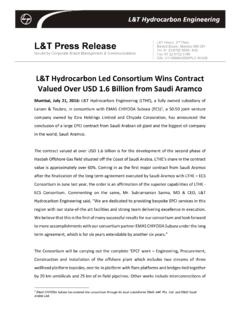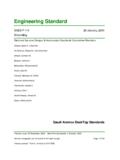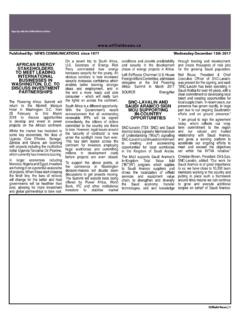Transcription of PETROLEUM ECONOMICS - National Cheng Kung University
1 29 Chapter Two PETROLEUM ECONOMICS Chapter One includes several charts containing historical economic statistics. Chapter Two emphasizes the importance of E&P reserve values and describes current ECONOMICS in terms of the leading countries and companies. A FOCUS ON ADDING RESERVE VALUE PETROLEUM exploration and production ECONOMICS center on the size and nature of oil and gas reserves in relation to oil and gas prices. An E&P company may be said to have two key assets: 1. Its people and their ability to profitably find (or acquire), develop, and produce oil and gas reserves and 2.
2 Its existing reserves and their ability, when produced, to generate positive cash flow. The ability to apply new technology (such as 3D seismic, horizontal drilling, deep water drilling and production techniques, and global internet knowledge sharing) will be key to managing risks and adding billions in reserve value for the E&P industry in the coming decade. E&P company managements appreciate that true exploration success is not measured by the success ratio, , the number of producible wells to total wells drilled. A ten-well program with discovery of a single large reservoir may be far more profitable than a ten-well program discovering five marginally economic reservoirs.
3 Nor is exploration success truly measured by the quantity of reserves found. In many remote parts of the world, large quantities of gas reserves have been found that have relatively limited value because transportation costs to gas markets are so high. A property with one million barrels of proved heavy, sour crude oil reserves with high future development and production costs might sell for only $1 million, while a fully developed property with one million barrels of proved light, sweet crude oil and low production costs might sell for $6 million. Hence, an E&P company often must evaluate potential E&P investments using sophisticated computer-generated, present value analyses of expected future cash flows.
4 Chapter 2 ~ PETROLEUM ECONOMICS 30 These analyses can project estimated future monthly production volumes, revenues, and production expenses per well over the well's economic life of many years. From these projected cash flows and the required investment, an expected annual rate of return and other profit indicators can be calculated to evaluate the investment's economic merits. Often a company's records of historical production, revenue, and cost categories by well and by field are instrumental in developing reasonable cash flow projections for investment decision making.
5 Such analysis is illustrated in Chapter Thirty on valuation of proved oil and gas properties. Historical cost may be dramatically greater or less than the value of reserves found. E&P financial statement accounting recognizes the economic importance of reserves in three ways: Capitalized costs of properties with proved reserves (proved properties) are amortized on a units-of-production method based on the ratio of volumes currently produced to the sum of those volumes and remaining proved reserves; Proved properties net capitalized costs are limited to certain computations of value of the underlying proved reserves.
6 And Public companies must disclose, with audited financial statements, certain supplemental unaudited information on the proved reserve volumes and certain related values. Even so, an E&P company's stock price is more closely correlated to historical and expected cash flow from production of reserves and to estimated values of reserves than to historical earnings measured under generally accepted accounting principles, as further discussed at the end of Chapter Twenty-Nine. PETROLEUM ECONOMICS TODAY FROM A GLOBAL PERSPECTIVE The world's reserve values by country are not publicly disclosed, but estimated reserve volumes are.
7 Figure 2-1 summarizes the world's proved oil and gas reserves, production, and oil wells by country. Over 92 percent of the world's proved oil and gas reserves are found in the 25 countries listed in Figure 2-1. The top ten countries have nearly 80 percent of the world s oil and gas reserves and the majority of the world s current production. Sixty-four percent of the world's proved oil reserves are in five Middle East countries, and the majority of the world's proved oil and Chapter 2 ~ PETROLEUM ECONOMICS 31 gas reserves are in only four countries Russia, Saudi Arabia, Iran and Iraq.
8 Figure 2-1: World Reserves and Production by Country Twenty-five largest Reserves (1/1/00) Annual Production (OPEC members in bold) Oil* Gas* Total Boe* Oil* Gas* Total Boe* Oil Wells* 1 Russia 49 1,700 382 2 Saudi Arabia 261 204 295 3 Iran 90 812 225 4 Iraq 113 110 131 - 5 Abu Dhabi (UAE) 92 196 125 - 6 Kuwait 94 52 103 7 Venezuela 73 143 97 8 Qatar 4 300 54 9 United States 21 164 48 10 Nigeria 23 124 44 11 Libya 30 46 38 12 Mexico 28 30 33 13 China 24 48 32 14 Algeria 9 130 31 15 Turkmenistan 1 101 18 16 Malaysia 4 82 18 17 Norway 11 41 18
9 18 Indonesia 5 72 17 19 Kazakhstan 5 65 16 20 Canada 5 64 16 21 Uzbekistan 1 66 12 22 Netherlands 0 63 11 23 Australia 3 45 11 24 Oman 5 28 10 25 United Kingdom 5 27 10 Subtotal 956 4,713 1,742 Others 60 433 132 Total 1,016 5,146 1,874 *Oil reserves and production are in billions of barrels. Gas reserves and production are in trillion cubic feet.
10 Combined total reserves and production are in billion barrels of oil equivalent at 6 mcf per barrel. Annual oil production is for 1999; annual gas production is for 1998. Numbers of producing oil wells are in thousands as of December 31, 1998. Primary Sources: Oil and Gas Journal, December 20, 1999 and BP Amoco Statistical Review of World Energy 1999 Chapter 2 ~ PETROLEUM ECONOMICS 32 The one trillion barrels of world oil reserves are 50 times current production (Figure 2-1). In 1950 that ratio was only 20. World oil reserves have increased nearly 80 percent since 1981, but virtually all of the increase is in OPEC countries.








